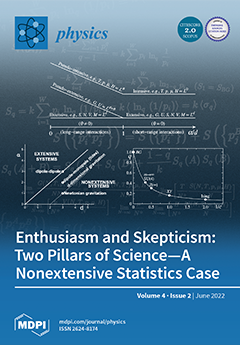The color transparency (CT) of a hadron, propagating with reduced absorption in a nucleus, is a fundamental property of QCD (quantum chromodynamics) reflecting its internal structure and effective size when it is produced at high transverse momentum,
Q. CT has been confirmed
[...] Read more.
The color transparency (CT) of a hadron, propagating with reduced absorption in a nucleus, is a fundamental property of QCD (quantum chromodynamics) reflecting its internal structure and effective size when it is produced at high transverse momentum,
Q. CT has been confirmed in many experiments, such as semi-exclusive hard electroproduction,
, for mesons produced at
. However, a recent JLab (Jefferson Laboratory) measurement for a proton electroproduced in carbon
, where
X stands for the inclusive sum of all produced final states, fails to observe CT at
up to 14.2 GeV
. In this paper, the onset of CT is determined by comparing the
-dependence of the hadronic cross sections for the initial formation of a small color-singlet configuration using the generalized parton distributions from holographic light-front QCD. A critical dependence on the hadron’s twist,
, the number of hadron constituents, is found for the onset of CT, with no significant effects from the nuclear medium. This effect can explain the absence of proton CT in the present kinematic range of the JLab experiment. The proton is predicted to have a “two-stage” color transparency with the onset of CT differing for the spin-conserving (twist-3,
) Dirac form factor with a higher onset in
for the spin-flip Pauli (twist-4) form factor. In contrast, the neutron is predicted to have a “one-stage” color transparency with the onset at higher
because of the dominance of its Pauli form factor. The model also predicts a strong dependence at low energies on the flavor of the quark current coupling to the hadron.
Full article





